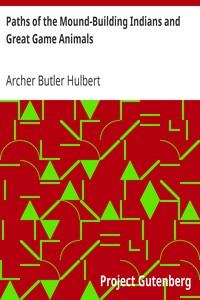Read this ebook for free! No credit card needed, absolutely nothing to pay.
Words: 17501 in 9 pages
This is an ebook sharing website. You can read the uploaded ebooks for free here. No credit cards needed, nothing to pay. If you want to own a digital copy of the ebook, or want to read offline with your favorite ebook-reader, then you can choose to buy and download the ebook.


: Paths of the Mound-Building Indians and Great Game Animals by Hulbert Archer Butler - American bison; Mound-builders; Indian trails United States
true proportion of the ancient works in the different sections," still some conclusions have already been reached which future exploitation will never weaken.
It is not expected that future investigation will change the verdict that the heaviest mound-building population found its seat near the Mississippi and Ohio rivers. "There is little doubt," writes Dr. Thomas, "that when Mississippi, Alabama, and Georgia have been thoroughly explored many localities will be added to those indicated ... but it is not likely that the number will be found to equal those in the area drained by the Ohio and its affluents or in the immediate valley of the Mississippi."
This fact, that the heaviest populations of the mound-building Indians seem to have been near the Mississippi and Ohio is, of course, shown by the archaeological maps. In a rough way, subject to the limitations previously mentioned, it can be found that the following fourteen states contain evidences of having held the heaviest ancient populations:
Ohio, Wisconsin, Tennessee, Illinois, Florida, New York, Kentucky, Indiana, Michigan, Georgia and Arkansas, Missouri and North Carolina, Minnesota, Iowa, Pennsylvania.
Now, by our last census the states which contain the largest population today are:
New York, Pennsylvania, Illinois, Ohio, Texas, Missouri, Massachusetts, Indiana, Michigan, Iowa, Georgia, Kentucky, Wisconsin, Tennessee.
Thus of the fourteen most thickly populated states today perhaps twelve give fair evidence of having been most thickly populated in prehistoric times. As a general rule the heaviest population has always been found in the best agricultural regions; the states having the largest number of fertile acres have had, as a rule, the largest populations--or did have until the cities grew as they have in the past generation.
This argument, though necessarily loose, still is of interest and of some importance in the present study. The earliest Indians found, without any question, the best parts of the country they once inhabited if we can take the verdict of the present race which occupies the land.
Coming down to a smaller scope of territory, can it be shown that in the case of any one state the early Indians occupied the portions most heavily populated today? It has been said that, in Ohio, four counties contain evidence of having been the scenes of special activity on the part of the earliest inhabitants: Butler, Licking, Ross, and Franklin. These are interior counties and, of the remaining sixty-three interior counties in the state, only seven exceeded these four in population in 1880--when the cities had not so largely robbed the country districts of their population as now. Thus the aborigines seem to have been busiest where we have been busiest in the last half of the nineteenth century.
In Wisconsin the mound-building Indians labored most in the southern part of the state, where the bulk of that state's population is today--seventy-five per cent being found in the southern half of the state.
In Michigan, a line drawn from the northern coast of Green Bay to the southwestern corner of the state includes a very great proportion of the archaeological remains in the state. That line today embraces on the southeast thirty-three per cent of the counties of the state, yet sixty-three per cent of the population.
Thus it can be said that in a remarkable measure the mound-building peoples found with interesting exactness the portions of this country which have been the choice spots with the race which now occupies it.
Free books android app tbrJar TBR JAR Read Free books online gutenberg
More posts by @FreeBooks

: History of the Reformation in the Sixteenth Century Volume 1 by Merle D Aubign J H Jean Henri Beveridge Henry Translator - Reformation


: From Gretna Green to Land's End: A Literary Journey in England. by Bates Katharine Lee - England Description and travel






